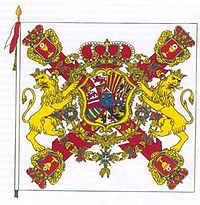Walloon Guards
| Walloon Guards Guardia Valona |
|
|---|---|

Military coat of arms of Philip V
|
|
| Active | 1703–1820 |
| Country |
|
| Allegiance |
|
| Branch |
|
| Type | Infantry |
| Role | Royal Guard |
| Engagements |
War of the Polish Succession War of the Austrian Succession Motín de Esquilache Spanish War of Independence |
| Commanders | |
| Notable commanders |
Ramón María Narváez |
The Walloon Guards (Gardes Wallonnes; in Spanish, Guardia Valona) were an infantry corps recruited for the Spanish Army in the region now known as Belgium, mainly from Catholic Wallonia. As foreign troops without direct ties amongst the Spanish population, the Walloons were often tasked with the maintenance of public order, eventually being incorporated as a regiment of the Spanish Royal Guard.
The Walloon Guards were first raised at a time when the Low Countries were under the Spanish Crown as the Spanish Netherlands. "Walloons" was the German (walah) name for their romanized neighbors. Initially Walloon line infantry regiments were formed by the Flemish, the Brabantians and Walloons to the number of 4,000 men and were recruited among the strongest and tallest men available, to spearhead assaults or to cover retreats.
The decision to raise a regiment of Walloon Guards was taken on 17 October 1702 by Philip V of Spain and the new unit arrived in Spain in December the following year. They were linked with the Spanish Guards (Gardes Espagnoles) raised shortly before. Both regiments had the same organisation, disciplinary regulations and uniforms of dark blue, red and silver. The model for both were the French Guards (Gardes Françaises) of the French Maison du Roi, a detachment of whom were sent to Spain in 1703 to act as instructors.
After the independence of the United Netherlands in 1648 and the cession of the Spanish Netherlands to Austria at the Treaty of Utrecht in 1714, Walloons continued to serve in the Spanish army together with foreign soldiers from Switzerland, Ireland, and Italy. The Walloon Guards remained a primarily Walloon unit, although the Austrian authorities attempted to discourage recruitment in the former Spanish Netherlands. Most officers of the Regiment came from long established Spanish families of Walloon origin. Similarly, some rank and file members of the regiment remained in Spain when their period of service was over, took Spanish wives and encouraged their sons to enlist in the various Walloon units of the Spanish Army.
...
Wikipedia
